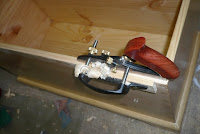Time has been a little tight but we still should be completed for Christmas. Fingers cross. After shaping the round over I joined the base moulding together. One box received more dovetails, the other a simple mitre.
The mitres are surprisingly ok considering they are handcut without a guide or good layout. The main gaps annoyingly are related to slippage during gluing rather than poor cutting. Next time I will use dowel or screws to align everything.
The four sides were glued to the case and the mitres/doevetails fitted around that.
I used my sketch up design printed 1:1 to layout the curves. I used woodglue to glue the paper to some MDF. Then used the MDF as a layout guide. The cuts were made with a jigsaw.
To go: finish the lid, sand the curves, round over all the edges, sand everything, lime, stain, varnish.... 12 days, 11 of which will be at work...




















































.png)